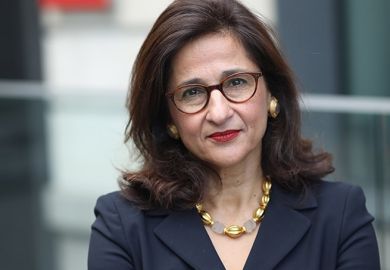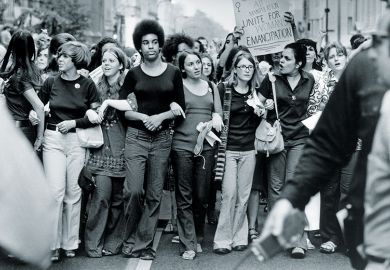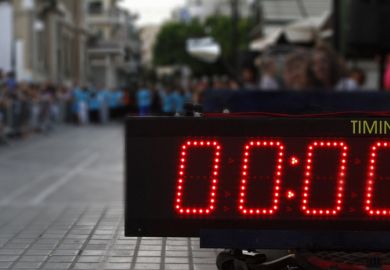Men are being paid significantly more per hour, on average, than their female colleagues at many of the UK’s largest and most prestigious universities, new data reveal.
So far, about one-third of British higher education institutions (46) have submitted their gender pay gap data ahead of the national deadline of 4 April, by which time every employer with more than 250 staff must declare its figures.
Of the universities to submit so far, six report a gap of more than 20 per cent between average male and female pay. Royal Holloway, University of London, fares particularly badly, with women paid a mean average of 27.2 per cent less per hour, and a median average of 33.8 per cent.
The second largest pay gap is at the University of Liverpool, which has a mean average gap of 24.6 per cent, ahead of the University of Bristol, with a gap of 21.1 per cent.
The figures come as increasing numbers of public and private industries are held to account for their institutional pay disparities. Earlier this month, broadcaster ITN declared that it pays its female employees 19.6 per cent less on average, while the figure at the BBC was 10.7 per cent.
Worse still were the data submitted by major banks, including HSBC, which had the largest gap reported to date, of 60 per cent.
Of the universities listed in the government’s pay gap transparency data so far, all admitted to paying their female employees significantly less per hour, on average, than their male employees. The vast majority revealed a gender pay gap in double figures, with the average standing at 13.9 per cent.
Dame Athene Donald, master of Churchill College, Cambridge, noted that it was “often hard to distinguish a genuine gender pay gap from the consequences of grade segregation by gender”.
“That there are more male professors than female is well known, but this can significantly impact on an apparent gender pay gap,” she said. “Actually, it could be that male and female professors are paid on average the same – that’s a different question which means and medians won’t show up.”
Many institutions attributed the disparities to a disproportionately low number of women employed in senior roles. The University of Sussex, which had the fourth largest gap reported so far, admitted that, while improvements had been made, “women are not rising through the ranks and Sussex is failing to attract women to senior posts”.
Several of the institutions with the largest mean gaps are larger, research-intensive universities, perhaps reflecting their bigger professoriates and the employment of clinical staff in medical schools.
However, even in institutions where as many women as men are employed in top positions, a pay gap is still evident. At Oxford Brookes University, for example, more women than men are employed on every level, with just over half of the most senior positions held by women (51.3 per cent), but the institution still admits to a mean pay disparity of 11.9 per cent.
An Oxford Brookes spokesman explained that, while “very well represented” at senior levels, women still outnumber men in the lowest-paid roles. Large numbers of those in the lowest pay quartile were students undertaking casual work, he added, “many of whom are women – which reflects the fact that 59 per cent of our student population is female”.
Royal Holloway said that it, too, “directly employs a large number of students as well as casual workers in junior grades, of whom a significant proportion are female”.
A spokesman added: “We recognise our responsibility to champion gender equality and have pioneered a number of initiatives to help close the gender pay gap…We have made progress, and this report brings into further focus the work we still have to do in this area.”
Evidence of a gender pay gap across higher education will come as little surprise. Last year’s Times Higher Education pay survey put the pay gap between male and female professors at 5.8 per cent in 2015-16, with progress towards equality appearing to have stalled.
Andrew Bazeley, policy and insight manager at gender equality charity the Fawcett Society, said that seeing the gap in individual institutions would “galvanise the women who work there to demand change”.
“It isn’t acceptable for vice-chancellors to stand back from this, or indeed to just say that ‘we have more senior men’. That’s a cause of the gap, and a huge problem for society and their organisations – not an excuse,” he said.
A number of universities have made conscious efforts to promote equality in recent years by introducing mentoring schemes to help women and minorities climb the career ladder.
The University of Liverpool said that, since implementing its own development initiatives, the organisation had seen an increase in the number of female professors, from 18 per cent of the total in 2012 to 25 per cent currently. “We are committed to building on these improvements to reduce our gender pay gap and a range of initiatives are under way to remove barriers and promote choice,” a spokeswoman said.
A Bristol spokesman highlighted that its median pay gap was below the national average. "The university and its senior leadership team is committed to closing the gender pay gap and will continue to embed practices to attract, retain and develop our talented female staff," he said.
rachael.pells@timeshighereducation.com
Gender pay gaps reported by UK higher education institutions to date
| Institution | Women's hourly rate | Top quartile pay | ||
| Mean (%lower) | Median (%lower) | Men (%) | Women (%) | |
| Royal Holloway, University of London | 27.2 | 33.8 | 62 | 38 |
| University of Liverpool | 24.6 | 19.0 | 61.8 | 38.2 |
| University of Bristol | 21.1 | 16.2 | 59 | 41 |
| University of Sussex | 20.8 | 15.3 | 65 | 35 |
| Newcastle University | 20.4 | 19.5 | 63 | 37 |
| University of Southampton | 20.2 | 17.4 | 62 | 38 |
| University of York | 19.3 | 17.7 | 62 | 38 |
| SRUC (Scotland's Rural College) | 19.1 | 26.8 | 55.9 | 44.1 |
| University of Bath | 17.8 | 17.9 | 63.5 | 36.5 |
| University of Bradford | 17.7 | 21.1 | 56.8 | 43.2 |
| University of Kent | 17.5 | 9.8 | 56.7 | 43.3 |
| Liverpool Hope University | 17.4 | 16 | 54 | 46 |
| Bath Spa University | 17.2 | 23.7 | 56 | 44 |
| University of Manchester | 17.1 | 13.1 | 60.6 | 39.4 |
| University of Lincoln | 16.9 | 7.1 | 62 | 38 |
| University of Gloucestershire | 15.5 | 18.5 | 57.7 | 42.3 |
| De Montfort University | 15 | 23 | 58 | 42 |
| University of Suffolk | 14.6 | 14.1 | 50.5 | 49.5 |
| University of Bedfordshire | 14.6 | 13.7 | 46 | 54 |
| University of Chester | 14.1 | 18.5 | 48 | 52 |
| University of Brighton | 14.1 | 16.3 | 53.7 | 46.3 |
| University of Surrey | 14.1 | 13.7 | 56 | 44 |
| University of Salford | 14 | 21 | 59 | 41 |
| University of Hertfordshire | 13 | 19 | 49 | 51 |
| University of Derby | 13 | 13.5 | 50 | 50 |
| University of the West of England | 13 | 11 | 52 | 48 |
| St Mary's University, Twickenham | 12.6 | 20.9 | 52 | 48 |
| Canterbury Christ Church University | 12.2 | 19.3 | 49 | 51 |
| University of Sunderland | 12 | 20.9 | 53 | 47 |
| Oxford Brookes University | 11.9 | 13.7 | 48.7 | 51.3 |
| Birmingham City University | 11.6 | 9.2 | 57 | 43 |
| Regent's University London | 11.5 | 4.8 | 55.9 | 44.1 |
| University of Central Lancashire | 10.9 | 8.4 | 51.6 | 48.4 |
| University of Northampton | 10.5 | 15.3 | 49.2 | 50.8 |
| Arts University Bournemouth | 10.3 | 18.1 | 44.6 | 55.4 |
| The Open University | 9.8 | 14.9 | 49 | 51 |
| Staffordshire University | 9.4 | 15 | 51.2 | 48.8 |
| Anglia Ruskin University | 9.3 | 11.9 | 49 | 51 |
| Liverpool John Moores University | 8.9 | 21.9 | 58 | 42 |
| Manchester Metropolitan University | 8.9 | 6 | 48.3 | 51.7 |
| London Metropolitan University | 8.6 | 11.5 | 57 | 43 |
| University of Westminster | 7.9 | 5.1 | 51.6 | 48.4 |
| Kingston University | 7.3 | 5.4 | 53.5 | 46.5 |
| London South Bank University | 6.7 | 5.4 | 49 | 51 |
| University of the Arts London | 5.6 | 7.1 | 48.9 | 51.1 |
| Leeds College of Art | 3.6 | 5.7 | 47.1 | 52.9 |
Source: Data submitted by institutions to UK government as of 19 March
POSTSCRIPT:
Print headline: Stark gender pay gap at UK institutions
Register to continue
Why register?
- Registration is free and only takes a moment
- Once registered, you can read 3 articles a month
- Sign up for our newsletter
Subscribe
Or subscribe for unlimited access to:
- Unlimited access to news, views, insights & reviews
- Digital editions
- Digital access to THE’s university and college rankings analysis
Already registered or a current subscriber?








